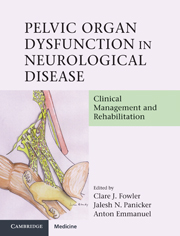Book contents
- Pelvic Organ Dysfunction in Neurological Disease
- Pelvic Organ Dysfunction in Neurological Disease
- Copyright page
- Contents
- Contributors
- Foreword
- Preface
- Section 1 Neurological control of pelvic organ functions
- Section 2 Evaluation and management
- Section 3 Specific conditions
- Chapter 11 Cortical and subcortical disorders
- Chapter 12 Parkinson's disease
- Chapter 13 Multiple system atrophy
- Chapter 14 Multiple sclerosis and other non-compressive myelopathies
- Chapter 15 Spinal cord injury
- Chapter 16 Spina bifida and tethered cord syndrome
- Chapter 17 Pelvic organ dysfunction following cauda equina damage
- 18 Neuromuscular disorders
- 19 Urinary retention
- Appendix 1: Management algorithms
- Appendix 2: Surveys and questionnaires
- Index
Chapter 17 - Pelvic organ dysfunction following cauda equina damage
from Section 3 - Specific conditions
Published online by Cambridge University Press: 06 December 2010
- Pelvic Organ Dysfunction in Neurological Disease
- Pelvic Organ Dysfunction in Neurological Disease
- Copyright page
- Contents
- Contributors
- Foreword
- Preface
- Section 1 Neurological control of pelvic organ functions
- Section 2 Evaluation and management
- Section 3 Specific conditions
- Chapter 11 Cortical and subcortical disorders
- Chapter 12 Parkinson's disease
- Chapter 13 Multiple system atrophy
- Chapter 14 Multiple sclerosis and other non-compressive myelopathies
- Chapter 15 Spinal cord injury
- Chapter 16 Spina bifida and tethered cord syndrome
- Chapter 17 Pelvic organ dysfunction following cauda equina damage
- 18 Neuromuscular disorders
- 19 Urinary retention
- Appendix 1: Management algorithms
- Appendix 2: Surveys and questionnaires
- Index
Summary
Keywords
- Type
- Chapter
- Information
- Pelvic Organ Dysfunction in Neurological DiseaseClinical Management and Rehabilitation, pp. 266 - 277Publisher: Cambridge University PressPrint publication year: 2010
- 1
- Cited by



